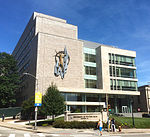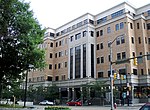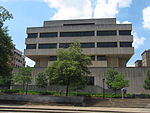Litchfield Towers

Litchfield Towers, commonly referred to on campus as "Towers", is a complex of residence halls at the University of Pittsburgh's main campus in the Oakland neighborhood of Pittsburgh, Pennsylvania. Litchfield Towers is both the largest and tallest residence hall at the University of Pittsburgh, housing approximately 1,850 students.Designed by the architectural firm of Deeter & Ritchey, the complex was completed in 1963 and was named for former chancellor Edward Litchfield following his death in an airplane crash in 1968. The complex consists of three towers, which during construction were designated A, B, and C in the architectural plans. The names stuck after the towers were completed, and the towers are still so named today. Towers A, B, and C house mostly first-year freshmen. The towers are all of different heights, and differ slightly in their living accommodations. Tower B is the tallest of the three, at 22 stories. Tower A is 19 stories tall, and Tower C is 16 stories in height. Rooms in Towers A and B are the same size, roughly 17 ft (5.2 m) by 11 ft (3.4 m). These measurements are not exact, however, because the three towers are cylindrical in shape (although actually twenty-sided) and the rooms themselves are therefore somewhat trapezoidal.
Excerpt from the Wikipedia article Litchfield Towers (License: CC BY-SA 3.0, Authors, Images).Litchfield Towers
Forbes Avenue, Pittsburgh
Geographical coordinates (GPS) Address Nearby Places Show on map
Geographical coordinates (GPS)
| Latitude | Longitude |
|---|---|
| N 40.442542 ° | E -79.957064 ° |
Address
Litchfield Towers complex
Forbes Avenue
15213 Pittsburgh
Pennsylvania, United States
Open on Google Maps








